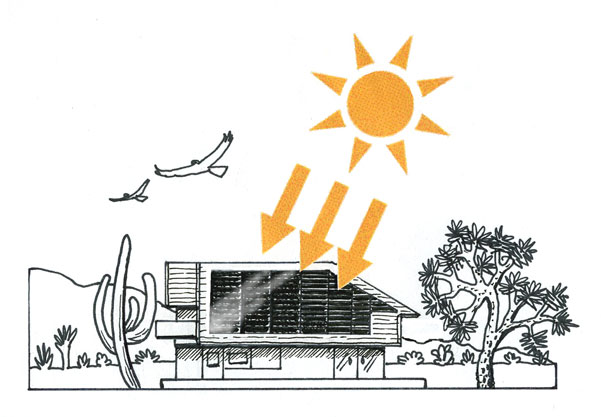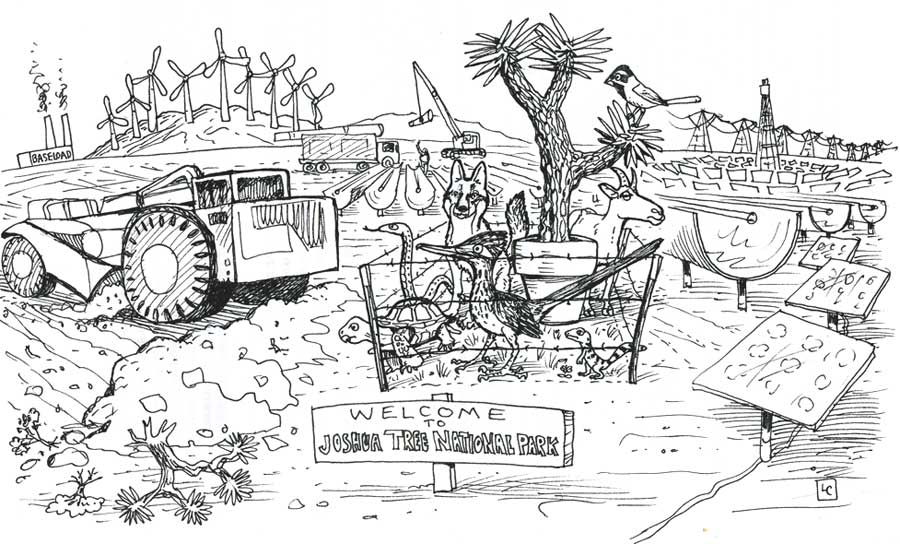
Rooftop Solar is the Better Alternative to DRECP
Basin & Range Watch, Solar Done Right, Desert Protective Council, Morongo Basin Conservation Association
August 8, 2016 - Basin & Range Watch also contributed content to this letter and were signatories opposing the Soda Mountain Solar Project signed by scientists concerned with conservation of the California Desert - Scientists Letter to San Bernardino County Opposing Soda Mountain Solar and Asking to Support Distributed Energy Resources.
August 4, 2016 - California Desert - The Desert Renewable Energy Conservation Plan (DRECP) is a major development plan for the expansion of renewable energy projects in the California Desert. The DRECP is focused on the desert regions and adjacent lands of seven California counties - Imperial, Inyo, Kern, Los Angeles, Riverside, San Bernardino, and San Diego. It is being prepared through a collaborative effort between the California Energy Commission, California Department of Fish and Wildlife, the U.S. Bureau of Land Management, and the U.S. Fish and Wildlife Service. Approximately 22.5 million acres of federal and non-federal California desert land are in the DRECP Plan Area. 10 millions acres of public lands are at stake. As part of Phase I, the BLM released the Proposed Land Use Plan Amendment and Final Environmental Impact Statement on November 10, 2015. Phase II would try to incorporate private lands across the desert into the DRECP.
The DRECP Preferred Alternative will have very large impacts on desert ecosystems, rural communities, and sensitive or federally threatened/endangered species like desert tortoise, burrowing owl, golden eagle, kit fox, flat-tailed horned lizard, Mojave fringed-toed lizard, and numerous rare plants. Iconic Joshua tree woodlands will need to be removed in places to make way for new roads, solar fields, and wind turbine generator pads. Groundwater in desert basins will need to be pumped for water wells for increased dust control and energy project usage.
Desert soils and living soil crusts that sequester Carbon will be disturbed, contributing to greenhouse gas emissions.
Archaeological and cultural resources are sometimes lost to large-scale energy developments. The land-use impact of this type of renewable energy is high.
The California Desert is an internationally famous tourist destination with its wide open spaces, feel of the Old West, and remoteness from built environments. Utility-scale energy development in this relatively pristine landscape would negatively impact tourism, visitor use of national park units, and local economies. Solar and wind projects are already proposed to be placed on the boundaries of popular national park units, harming viewscapes.
But what is missing from the DRECP are Alternatives that would avoid developing more desert ecosystems: rooftop solar and distributed energy resources in load centers of California.
Even with new conservation areas, the Desert Renewable Energy Conservation Plan will result in more energy sprawl and a smaller fragmented California Desert. This development plan is full of too many trade-offs. Distributed renewable energy generation and storage in the built environment are the future of renewable energy technology and can meet our needs without sacrificing more desert ecosystems.

Sand verbena (Abronia villosa) in a Development Focus Area in Chuckwalla Valley, Riverside County California.
Better Alternatives: Solar Done Right
There are better and more progressive alternatives to this fragmentation of the California Desert.
--The DRECP is primarily focused on rapidly expanding large-scale energy development in fragile desert ecosystems, rather than on the urgent need to transition the state’s electrical systems to clean power in the fastest and least harmful way, and to permanently conserve our intact, carbon-sequestering desert wildlands.
--In contrast, focus on the point-of-use solar alternative, developed by the California Public Utilities Commission and investor-owned utilities and known as the California Energy Efficiency Strategic Plan would avoid the industrial development of vast tracts of public lands and construction of hundreds of miles of associated and expensive transmission lines. (see http://www.energy.ca.gov/ab758/documents/CAEnergyEfficiencyStrategicPlan_Jan2011.pdf)
--US Department of Energy says, “The number of U.S. households with rooftop solar is rapidly growing. The amount of grid-connected solar is expected to double in just two years. With this large number of PV homes in the U.S. and a continuing robust market for additional PV installations, an ever-increasing number of PV homes will likely be sold or refinanced.” (http://energy.gov/eere/sunshot/articles/all-about-solar-and-real-estate-0)
--US Department of Energy’s National Renewable Energy Laboratory (NREL) released a report in March 2016 Rooftop Solar Photovoltaic Technical Potential in the United States: A Detailed Assessment, which says 1,118 GW of capacity and 1,432 TWh of annual energy generation was possible, equivalent to 39% of current US electricity sales. This is almost double the previous analysis undertaken and reported in 2008. The significant difference was said to be attributed to increases in PV module power density, improved estimation of building suitability, higher estimates of the total number of buildings, and improvements in PV performance simulation tools that previously tended to underestimated production.
--NREL reports that California has the greatest potential to offset electricity use—its rooftop PV could generate 74% of the electricity sold by its utilities in 2013 . California small and large rooftops have the potential to generate 131.8 GW of solar (http://www.nrel.gov/docs/fy16osti/65298.pdf).
--Los Angeles alone has the rooftop potential for 9,000 MW of solar (ibid. page 19). We’d have to build almost 24 more Ivanpah solar power tower projects to match that.
--Over 39,000 MW of solar PV can be utilized on parking lot structures alone.
--Policy failures often limit the rapid build-out of Distributed Generation in built areas, as witnessed by the ongoing controversies in CA and NV concerning rooftop solar net energy metering.
--A rooftop solar plus storage and energy efficiency with smartgrid modernization alternative would eliminate the need for any Take permits or other modifications that would otherwise compromise the Endangered Species Act. This would greatly reduce environmental impacts and significant effects to desert lands and local desert communities.
--A Distributed Energy Resource alternative leaves these species, their habitats, and their ecological linkages intact and would be the alternative that best meets long-term conservation of the California desert. A true conservation plan.

Huge Land Use of the California Desert Under DRECP Can Be Avoided
1.Development Focus Areas include 388,000 acres of BLM lands, with many new areas. That is 606 square miles of desert.
2. Variance Process Land would allow development on another 40,000 acres of desert lands.
3. Unallocated Lands includes a huge amount: 536,000 acres. These are BLM-administered lands that do not have an existing or proposed land allocation or designation in the DRECP, but would also be a potential energy sprawl zone if developers seek such areas.
4.This would add up to 1,506 square miles of desert wildlands opened up for energy development. Desert soils, plant communities and biological soil crusts sequester Carbon, disturbing these desert ecosystems by construction and road-building would potentially release large amounts of greenhouse gases. The National Park Service issued a report on the high level of CO2 sequestration for desert parks including Mojave National Preserve, with similar vegetation and soils to the adjacent Soda Mountain area (Leslie Richardson, Christopher Huber, Zhiliang Zhu, and Lynne Koontz. 2014. Terrestrial Carbon Sequestration in National Parks: Values for the Coterminous United States. Natural Resource Report NPS/NRSS/EQD/NRR—2014/880).
5. Conservation areas are not as conserved as we would like: BLM explained at public meetings that both Areas of Critical Environmental Concern (ACECs) and National Conservation Lands (NCLs) in the DRECP have disturbance caps that differ in the various alternatives and between regions. Some are as high as 12%, others below 1%. Present ACECs have a 1% development cap. The Yuha ACEC (Imperial County, California) designated to protect the rare Flat-tailed horned lizard already has 0.9% development in it. The incremental chipping away of our beautiful Mojave and Colorado Desert wildlands must stop. What more development will be proposed in the future to reduce our desert wildlands even more?

Unique Desert Landscapes Under Threat
A sample of some of the desert landscapes we have personally visited that are opened for development for utility-scale energy:
Soda Mountain and valley: the Soda Mountain alluvial fans on the border of the popular Mojave National Preserve would not be protected from pending solar developments. Solar projects could inhibit desert bighorn sheep movement corridors here.
Trona Pinnacles: the Searles Lake area famous for the Trona Pinnacles has been added as a renewable energy development zone. This area is famous for Hollywood movie sets from Westerns to Science Fiction, so we are amazed it has been slated for large-scale energy development. The small town of Trona and Searles Dry Lake are currently a remote area with mineral salt mining but the surrounding desert is largely untouched and in a primitive setting. Archaeology around Searles Lake is phenomenal, since it was an Ice Age center of early human habitation in North America. We are concerned that the late addition of this desert as a Development Focus Area without the ability of the public to comment on a more extensive environmental review will enable the destruction of valuable natural and cultural resources. Will the view from the unique Trona Pinnacles be ever altered with industrial utility-scale solar projects and accompanying transmission lines and substations?
The area south of the Rand Mountains and north of Boron along highway 395 is designated as a Development Focus Area. This is not disturbed desert, but a prime example of intact western Mojave Desert. We have seen this area filled with wildflowers such as Mojave aster, Desert Dandelion, and pincushion during rainy springs. Desert tortoise, kit fox, and rare Mojave ground squirrel make this place home. The area is a Mojave ground squirrel population area and so it is surprising a DFA was designated here.
Koehn Dry Lake was also designated as a Development Focus Area, yet it is a hard-surface playa with muddy ooze just underneath the dry crust; vehicles driving onto the lakebed have sunk in and become stuck. Solar projects cannot be built on such a playa. There are many flaws in the Final DRECP.
Riverside East is a large area of Colorado Desert/Mojave Desert transition with beautiful desert ironwood and blue palo verde tree woodlands, sand dunes, playas, and fields of wildflowers in spring. We have tracked Mojave fringe-toed lizards here, observed the sign of the desert burro deer, and accompanied local residents and members of Tribes to view the wonders of cultural landscapes in this area.
Science Recommendations Not Followed
Basin & Range Watch recommends that agencies follow the Final Report of the Independent Science Advisors to the Desert Renewable Energy Conservation Plan. The Final DRECP, however, fails to do this and streamlines the permitting process instead of taking the time to do baseline biological surveys, set up control study sites, and design statistically valid long-term monitoring protocols.
The independent Science Advisors recommend, for example, says:
“As with the Mohave ground squirrel, and as justified in Section 4.4.2, the advisors do not recommend translocation of desert tortoise as effective mitigation or conservation action, in part because translocated tortoises suffer high mortality rates. “(Section 5.2, http://www.energy.ca.gov/2010publications/DRECP-1000-2010-008/DRECP-1000-2010-008-F.PDF)
Yet tortoise translocation has been carried out on every major solar project where the species is present, and translocation will undoubtedly continue as the main method to “clear” desert ecosystems of this Federally Threatened species to make way for industrial energy development.
The Independent Science Advisors recommended mitigating the confusing polarized glare of photovoltaic projects to decrease avian mortality, try to site solar projects on disturbed/degraded land, and to avoid playas. We see very little of these recommendations being followed in the final DRECP.
In a research study, Rebecca Hernandez, postdoctoral fellow at University of California, Berkeley, and a former ecologist at the Carnegie Institution, said, “We see that ‘big solar’ is competing for space with natural areas. We were surprised to find that solar energy development is a potential driver of the loss of California’s natural ecosystems and reductions in the integrity of our state and national park system “
(http://www.climatecentral.org/news/solar-study-sees-ecological-risks-19568?utm_content=buffer44383&utm_medium=social&utm_source=twitter.com&utm_campaign=buffer).
Rooftop solar is truly smart from the start!
Contact:
Laura Cunningham, Executive Director, Basin & Range Watch,
Kevin Emmerich, Co-founder, Basin & Range Watch
emailbasinandrange@gmail.com
Office phone: 775-553-2806
Cell: 775-513-1280

HOME.....DRECP.....California Energy Efficiency Strategic Plan
